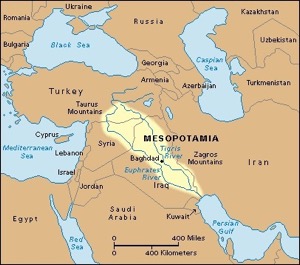Mesopotamia
Origin
The regional toponym Mesopotamia comes from the ancient Greek root words μέσος (meso) "middle" and ποταμός (potamos) "river" and literally means "(Land) between rivers". It is used throughout the Greek Septuagint (ca. 250 BC) to translate the Hebrew equivalent Naharaim.
An even earlier Greek usage of the name Mesopotamia is evident from The Anabasis of Alexander, which was written in the late 2nd century AD, but specifically refers to sources from the time of Alexander the Great. In the Anabasis, Mesopotamia was used to designate the land east of the Euphrates in north Syria.
The Aramaic term biritum/birit narim corresponded to a similar geographical concept. Later, the term Mesopotamia was more generally applied to all the lands between the Euphrates and the Tigris, thereby incorporating not only parts of Syria but also almost all of Iraq and southeastern Turkey. The neighbouring steppes to the west of the Euphrates and the western part of the Zagros Mountains are also often included under the wider term Mesopotamia.
Definition
- 1: an ancient region of southwestern Asia in present-day Iraq, lying between the Tigris and Euphrates rivers. Its alluvial plains were the site of the civilizations of Akkad, Sumer, Babylonia, and Assyria.
Description
Mesopotamia (/ˌmɛsəpəˈteɪmiə/, from the Ancient Greek: Μεσοποταμία "[land] between rivers"; from Ancient Armenian՝ Միջագետք(Mijagetq), Arabic: بلاد الرافدين bilād ar-rāfidayn; Persian: میانرودان miyān rodān; Syriac: Beth Nahrain "land of rivers") is a name for the area of the Tigris–Euphrates river system, roughly corresponding to modern-day Iraq, Syria and Kuwait, including regions along the Turkish-Syrian and Iran–Iraq borders.
Widely considered to be the one of the cradles of civilization by the Western world, Bronze Age Mesopotamia included Sumer and the Akkadian, Babylonian, and Assyrian empires, all native to the territory of modern-day Iraq. In the Iron Age, it was controlled by the Neo-Assyrian and Neo-Babylonian Empires.
The indigenous Sumerians and Akkadians (including Assyrians and Babylonians) dominated Mesopotamia from the beginning of written history (c. 3100 BC) to the fall of Babylon in 539 BC, when it was conquered by the Achaemenid Empire. It fell to Alexander the Great in 332 BC, and after his death, it became part of the Greek Seleucid Empire.
Around 150 BC, Mesopotamia was under the control of the Parthian Empire. Mesopotamia became a battleground between the Romans and Parthians, with parts of Mesopotamia coming under ephemeral Roman control. In AD 226, it fell to the Sassanid Persians and remained under Persian rule until the 7th century Muslim conquest of Persia of the Sasanian Empire. A number of primarily neo-Assyrian and Christian native Mesopotamian states existed between the 1st century BC and 3rd century AD, including Adiabene, Osroene, and Hatra.
Mesopotamia is the site of the earliest developments of the Neolithic Revolution from around 10,000 BC. It has been identified as having "inspired some of the most important developments in human history including the invention of the wheel, the planting of the first cereal crops and the development of cursive script, Mathematics, Astronomy and Agriculture." A modern Mesopotamian identity is espoused by the ethnically indigenous Mesopotamian and Eastern Aramaic speaking people, known as Assyrians and Chaldean Christians.[1]
Quote
All this explains how the Sumerians appeared so suddenly and mysteriously on the stage of action in Mesopotamia. Investigators will never be able to trace out and follow these tribes back to the beginning of the Sumerians, who had their origin two hundred thousand years ago after the submergence of Dalamatia. Without a trace of origin elsewhere in the world, these ancient tribes suddenly loom upon the horizon of civilization with a full-grown and superior culture, embracing temples, metalwork, agriculture, animals, pottery, weaving, commercial law, civil codes, religious ceremonial, and an old system of writing. At the beginning of the historical era they had long since lost the alphabet of Dalamatia, having adopted the peculiar writing system originating in Dilmun. The Sumerian language, though virtually lost to the world, was not Semitic; it had much in common with the so-called Aryan tongues. (77:4.7)
